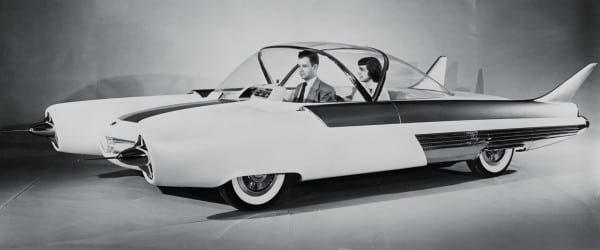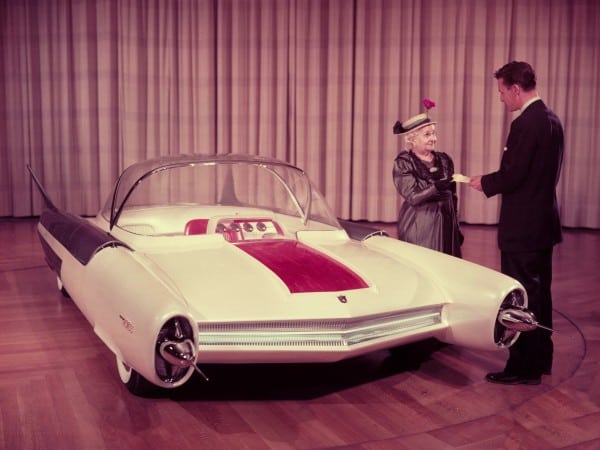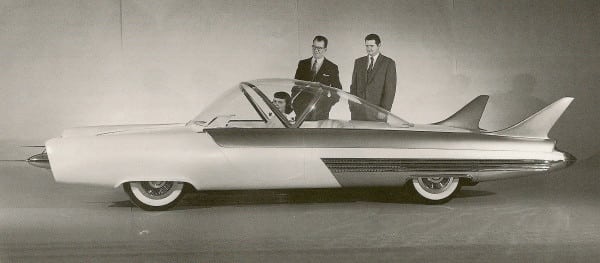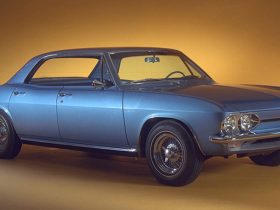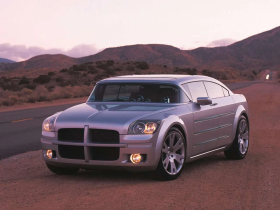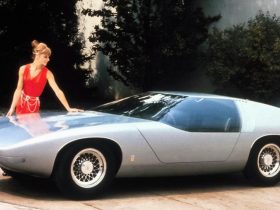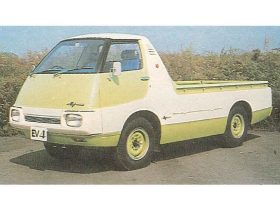The 1950s were full of wacky concepts. The space age was on in full tilt; science fiction was becoming one of the most popular themes for movies, television and books; and cars were often designed after airplanes and rocket ships. Enter the FX-Atmos from Ford.
Introduced in 1954 as a conceptual, the FX-Atmos had far out styling, a Jetsons-like cockpit, a centralized driving position, joystick controls, and a rear monitor meant for who-knows-what purpose. Truly an outlandish conceptual design, the purported futuristic nuclear engine seemed almost an afterthought. The Future eXperimental ATMOSphere was a pure concept, unable to roll under its own power.
Yet some of the items in this car can be viewed as very forward-looking and the car’s overall design itself became the backdrop for the now-famous Futura concept to come – the car which became the classic Batmobile we all know and love, long before Bruce Wayne was re-invented as a weapons design mogul.
A Rocket Ship On Wheels
The Ford FX-Atmos concept begins at front with two huge “pedestrian skewers” (actually said to be antenna for radar per the aircraft of the time) – long pointy needles protruding from the nose cones of the large intake-like round fenders at front. Between those fenders, a bat-shaped grille thinly grinned. The round intakes gave way to big, oval fenders that extended down the body of the car to the rear, where they tapered into jet exhaust-styled rear tail lamp bezels with huge fins sticking up at a rakish, outward angle.
The central body, starting at that Cheshire grille, rolled in a fuselage-inspired flattened oval backwards to the deck lid with its rear conical shape, interrupted only by the glass cockpit which covered the center of the car like Wonder Woman’s invisible plane in the horrible special effects to come years later to color television.
The dome of glass was broken only by two thin, steel bands meant to stabilize it and allow it to fold in on itself as the windscreen lifted and opened to allow entry into the interior.
Underneath all this space ship bodywork emerged the edges of four white-walled tires.
The Interior and Future Tech
Inside that glass-domed cockpit was a futuristic driving experience which had seen no equal and would, frankly, never be seen in production. The centrally-located driver’s seat looked straight out over the sloping hood with gauges set in “heads up” fashion directly ahead.
Those looking for a steering wheel would be disappointed as the FX-Astro was controlled by two joysticks similar to the flight sticks used in fighter jets – a brand new innovation in avionics at that time. The sticks sat to either side of the pilot’s seat at elbow-level and (theoretically) controlled the car tank fashion – moving one or the other forward or backwards would change the steering angle of the car as one side slowed and the other sped up to turn.
Behind the driver’s seat were two passenger’s seats set in tandem. The huge amount of glass on top of the car meant a full field of view for everyone inside. Don’t worry, the extra-wide boat-like dimensions of this car meant the chances of rollover were slim to none.
A TV screen was mounted directly behind the driver’s seat for the rear passengers, though for what purpose is now lost to time. Likely it was for the entertainment of the passengers.
Cool Stuff That Didn’t Work
We might think it amusing now, but at the time, some of the ideas in the Ford FX-Atmos were downright prognostic. Not the least of those was the idea of implementing radar to allow the car to both communicate with others on the road and avoid collisions. To this end, the huge skewers sticking out the front of the Atmos were actually radar needles capable of creating a 3-dimensional “view” of things ahead of the car. This is almost an everyday technology in today’s vehicles.
The joystick controls were also an unusually bold idea, though they obviously never caught on. Under the hood was a nuclear-powered engine that propelled the car in an unspecified manner. “Powered by the atom,” Ford chimed, meant that the FX-Atmos didn’t require refueling, grease, oil, or any other type of service. In 1954, that was a pretty outlandish idea, given the frequency those old lead-laden motors required service. No one can be certain, but had the Atmos actually had a nuclear engine, it probably made the Pbbbtttbbbb of the Jetsons mobile.
Overall, the shape of the car was also aerodynamically sound, though no wind tunnels were used to test vehicles at the time. We can guess, though, that the FX-Atmos likely had an excellent drag coefficient, relatively speaking.
Where Is It Now?
The fate of the 1954 Ford FX-Atmos is unknown. It was showcased for about a year and spent a short amount of time in the Henry Ford Museum. Most likely it was destroyed, as it was purely a design exercise and would inspire no production vehicles in its time.
We can, however, thank the mysterious and thought-provoking Atmos for bringing us the most famous Ford concept of all time – the long-lived and most collectible Futura Batmobile.




